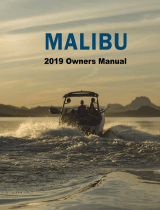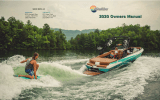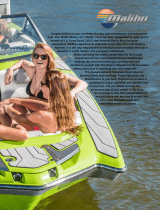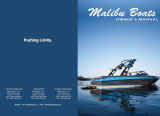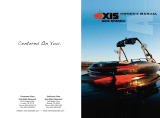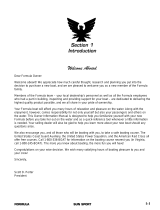Page is loading ...

2016 Owners Manual
malibu boats, llc.
tennessee
5075 Kimberly Way
Loudon, TN 37774
(865) 458-5478
california
One Malibu Court
Merced, CA 95341
(209) 383-7469
australia
813 Hope Court
Albury, N.S.W. 2640
(02) 6040-1174

INTRODUCTION
Congratulations on your purchase of a new high-performance
recreational tow boat. Your Malibu Boats, LLC (“Malibu) boat has been
constructed to meet and/or exceed all U.S. Coast Guard (USCG) and
National Marine Manufacturers Association (NMMA) requirements
applicable at the time of its manufacture. However, it is still your
responsibility as the boat owner to ensure the boat is operated in a safe
manner and is properly maintained.
Before operating this vessel, please take the time to get acquainted
with the vessel and its various features and controls. We recommend
that you carefully read and familiarize yourself with this
Owner’s Manual and all on-product safety labels prior
to operating your new watercraft. This manual contains
important information on Boating Safety, Boating Rules, Proper
Operation and Maintenance of your boat. This manual provides a
guideline for proper operation and maintenance of your boat, and you
should consider it a permanent part of your vessel. In the event that this
boat is sold, this manual should be included along with the boat to ensure
that it will provide the same important information to the next owner.

ABOUT THIS OWNER’S MANUAL
The recommended practices and warnings in this manual represent sound advice for recreational boating and identify common
risks encountered by boaters engaging in towed watersport activities. Read and understand the contents of this manual. Ask
questions of a boating professional if anything in this manual does not make sense to you. The manual does not cover all instances
of risk or danger, so please use common sense and good judgment when boating. If you follow the advice provided in this manual
you will signicantly reduce risk to yourself, your passengers, towed participants, and other boaters.
This manual is not intended to be a substitute for taking a course on boating safety nor is it a substitute for boating experience.
It is recommended that if you are unfamiliar with the use and operation of a boat you seek advice and training from a qualied
individual or organization. Check with your local marine law enforcement agency or dealer for more information about boating
safety classes in your area.
The precautions listed in this manual and on the boat are not all-inclusive. If a procedure or method is not specically
recommended, YOU must be satised that it is safe for you and your passengers, and that the boat will not be damaged or made
unsafe as a result of your decision. Remember - always use caution and common sense when operating and maintaining your boat!
ABOUT YOUR NEW BOAT
Malibu is proud to provide you with the most exciting, cutting-edge technology available in the towing-boat industry. The boat
you have purchased represents the state of the art at the time of manufacture. As you may expect from the industry’s leader since
1982, Malibu expands and innovates continually. As a result, updated product or specications may be introduced during any given
model year. Malibu reserves the right to introduce new product or changes to existing model lines without notication or incurring
responsibility to make the same changes to boats in the market completed prior to the date of change.
This Owner’s Manual has been compiled to address as many potential issues and questions as may arise in addition to
explaining how to operate the boat and its systems correctly and safely as possible to ensure long-term and enjoyable use.
However, Malibu cannot anticipate every potential situation that can arise, affecting the care and protection of your boat, nor every
circumstance that could arise in the operation or care of the boat when not in use. Malibu strongly recommends reading any and
all additional information provided by component manufacturers’ and supplied with the boat at time of purchase. Also check out
websites for Malibu and its component manufacturers periodically to stay abreast of any changes, updates, service bulletins and
general information. Malibu will use these various methods of communication, from this Owner’s Manual and including, but not
limited to, direct mail contact and website updates, to make every reasonable effort to apprise you of the information you will need
to continue long-term and highly satisfactory use of your boat.

copyright july 2015, malibu boats llc, all rights reserved.

TABLE OF CONTENTS

Safety
Embracing Safety
Signal Words and Symbols Used In This Manual .............................................. 1-1
Basic Safety Rules ............................................................................ 1-2
Pre-operation Check List–Before Leaving the Dock ........................................ 1-2
Precautions While Underway ........................................................................... 1-3
Safety While Maintaining the Vessel ................................................................ 1-5
Owner Responsibility and Boating Education ............................... 1-6
Important Safety Information ............................................................................ 1-6
Responsibilities of Boat Owner and Operators ................................................ 1-6
Registration ...................................................................................................... 1-6
Insurance .......................................................................................................... 1-6
Boating Safety Education Opportunities ........................................................... 1-7
Operation by Minors and Licensing .................................................................. 1-7
Safety and Required Equipment ..................................................... 1-7
Navigation Lights .............................................................................................. 1-8
Emergency Safety Stop Switch ........................................................................ 1-8
Personal Flotation Devices ............................................................................... 1-9
Fire Extinguisher ............................................................................................ 1-10
Horn or Whistle ............................................................................................... 1-10
Bilge Pump(s) ................................................................................................. 1-10
Visual Distress Signals ................................................................................... 1-10
Recommended Safety Equipment .................................................................. 1-10
General Boating Safety Topics ...................................................... 1-11
Safe Speed ..................................................................................................... 1-11
Passenger Safety ........................................................................................... 1-11
Carbon Monoxide Safety ................................................................................ 1-12
Proper Loading ............................................................................................... 1-14
Weighting Your Boat During Watersport Activities .......................................... 1-14
Visibility of the Operator ................................................................................. 1-15
Boating Under the Inuence ........................................................................... 1-16
Product Misuse ............................................................................................... 1-16
Reporting Accidents ....................................................................................... 1-16
Rendering Assistance ..................................................................................... 1-16
Hazardous Conditions .................................................................................... 1-16
Environmental Concerns ................................................................................ 1-18
On Product Warning Labels ......................................................... 1-19
Warning Labels & Locations ........................................................................... 1-20
Basic Rules of the Road ................................................................. 1-24
Boating Regulations ....................................................................................... 1-24
Encountering Another Vessel ......................................................................... 1-24
Privileged Vessel ............................................................................................ 1-24
Burdened Vessel ............................................................................................ 1-24
Crossing ......................................................................................................... 1-24
Meeting Head-On ........................................................................................... 1-25
Overtaking ...................................................................................................... 1-25
General Prudential Rule ................................................................................. 1-26
Other Rules of the Road ................................................................................. 1-26
Aids to Navigation .......................................................................................... 1-26
Night Running ................................................................................................. 1-28
Watersports Safety ......................................................................... 1-29
Hand Signals .................................................................................................. 1-30

Towed Person Safety Responsibilties ............................................................ 1-30
Additional Precautions for Towed Skier/Rider ................................................ 1-30
Tow Line Guidelines ....................................................................................... 1-31
Fallen Skier or Rider ....................................................................................... 1-32
Develop WATER SENSE ............................................................................... 1-32
Watersports Safety Code ............................................................................... 1-33
Emergency Procedures .................................................................. 1-34
Explosion and Fire .......................................................................................... 1-34
Swamping and Flooding ................................................................................. 1-35
Capsizing ........................................................................................................ 1-35
Staying Aoat ................................................................................................. 1-35
Collisions ........................................................................................................ 1-35
Grounding ....................................................................................................... 1-36
Person Overboard .......................................................................................... 1-36
Drowning ........................................................................................................ 1-36
Medical Emergency ........................................................................................ 1-36
Operation Failure ............................................................................................ 1-36
Towing ............................................................................................................ 1-36
Functionality
Quick Reference Guide
Response ......................................................................................................... 2-2
LXR .................................................................................................................. 2-4
TXi .................................................................................................................... 2-6
Wakesetter 20 VTX .......................................................................................... 2-8
Wakesetter 20 VLX ........................................................................................ 2-10
Wakesetter 23 LSV ........................................................................................ 2-12
Wakesetter 25 LSV ........................................................................................ 2-14
Wakesetter 20 MXZ ........................................................................................ 2-16
Wakesetter 22 MXZ ........................................................................................ 2-18
Wakesetter 24 MXZ ........................................................................................ 2-20
Recommended Seating .................................................................................. 2-22
Dashes and Video Screens
Wakesetter Dash & Video Screen .................................................... 2-24
Engine Starting Code ..................................................................................... 2-24
Optional Joystick Controller (Sport Dash) ...................................................... 2-24
System Overview ........................................................................................... 2-24
Instrumentation ............................................................................................... 2-25
The Four Corners ........................................................................................... 2-25
Depth Screen ................................................................................................. 2-25
Ballast Screen ................................................................................................ 2-26
Speed Control ................................................................................................ 2-27
Surf Gate Control ........................................................................................... 2-28
Power Wedge Control .................................................................................... 2-29
Media Screen ................................................................................................. 2-31
Text/Call Alert ................................................................................................. 2-32
Drain Plug Warning ........................................................................................ 2-32
Stereo Screen ................................................................................................ 2-32
SiriusXM Operation ........................................................................................ 2-33
Viper II Bluetooth ............................................................................................ 2-35
Controls Screen .............................................................................................. 2-35
Setting Screen ................................................................................................ 2-35
Maps Screen .................................................................................................. 2-37
Dash, Gauges and Video Screen for Response, LXR
and TXi (including optional TXi 6.5” Screen .............................. 2-39
Tachometer ..................................................................................................... 2-39
Speedometer .................................................................................................. 2-40

Engine Temperature ....................................................................................... 2-40
Fuel ................................................................................................................ 2-40
Oil Pressure .................................................................................................... 2-40
Malibu Graphical In-Dash Display .................................................................. 2-41
Maliview Setup Screen ................................................................................... 2-41
Malibu Surf Gate ............................................................................................ 2-42
Basic Electrical Components ........................................................ 2-51
Battery Charger .............................................................................................. 2-52
12-Volt Receptacle ......................................................................................... 2-52
Alarms ............................................................................................................ 2-53
How It Works
Safety First ..................................................................................... 2-54
Fire Extinguishing Equipment ......................................................................... 2-54
Emergency Engine Stop Switch ..................................................................... 2-55
Lighting ........................................................................................................... 2-55
Tie-Ups ........................................................................................................... 2-56
Anchor Locker ................................................................................................ 2-58
Horn ................................................................................................................ 2-58
Mirror .............................................................................................................. 2-58
Ladder ............................................................................................................ 2-58
Fuel Fill ........................................................................................................... 2-58
Interior Performance ..................................................................... 2-59
Steering Wheel ............................................................................................... 2-59
Shifter/Throttle ................................................................................................ 2-59
Electronic Throttle Control (ETC) ................................................................... 2-60
Pylon(s) .......................................................................................................... 2-60
Sports Dash .................................................................................................... 2-61
Back-Up Camera ............................................................................................ 2-61
Interior Luxury .............................................................................. 2-62
Stereo Components ....................................................................................... 2-62
Seating ........................................................................................................... 2-62
Heated and/or Powered Driver’s Seat ............................................................ 2-63
Armrests ......................................................................................................... 2-63
Glovebox ........................................................................................................ 2-63
Storage Compartments .................................................................................. 2-64
Removable Cooler .......................................................................................... 2-64
Cup Holders ................................................................................................... 2-65
Removable Trash Receptacle ........................................................................ 2-65
Carpets and Mats ........................................................................................... 2-65
Cockpit Table .................................................................................................. 2-65
Grab Handles ................................................................................................. 2-66
Heater ............................................................................................................. 2-66
Rider Control Wristwatch ................................................................................ 2-67
Inverter ........................................................................................................... 2-67
Tower, Canvas & Accessories ......................................................... 2-67
G3.2 Tower ..................................................................................................... 2-67
G4 Tower ........................................................................................................ 2-68
Tower Accessories .......................................................................................... 2-69
On and Under the Water ............................................................... 2-71
Blower System ............................................................................................... 2-71
Bilge System .................................................................................................. 2-72
Ballast System ................................................................................................ 2-74
Power Wedge II .............................................................................................. 2-75
Surf Gate ........................................................................................................ 2-76
Rudder, Fins, Struts, Propeller, Paddle Wheel, Raw Water Intake ................ 2-77

Shower/Wash Down ....................................................................................... 2-78
Swim Platform and Ladders ........................................................................... 2-79
Salt Water Series ............................................................................ 2-79
Get Ready
Prior to Starting
Malibu Fuel System ......................................................................... 3-2
Final Checks Before Starting........................................................... 3-3
Starting and Operation
Starting the Engine .......................................................................... 3-4
Ignition Slot Only (Response and LXR) ............................................................ 3-4
Equipped with Start-Stop Button–Mechanical Button (Wakesetters
or Touch Screen (TXi) ................................................................................. 3-4
For Both Types of Starting Systems ................................................................. 3-5
To Turn Off ........................................................................................................ 3-5
Break-In Period ............................................................................... 3-5
Smart Operations ............................................................................ 3-5
Stopping ........................................................................................... 3-6
High Speed Maneuvers .................................................................... 3-6
Special Conditions .......................................................................... 3-6
Towing and Interaction ................................................................... 3-7
Anchoring ........................................................................................ 3-7
Docking and Tie-Up ........................................................................ 3-7
Safeguarding the Malibu Experience
Care & Maintenance
On-Going Care ................................................................................ 4-2
General Cleaning ............................................................................................. 4-2
Canvas ............................................................................................................. 4-2
Upholstery ........................................................................................................ 4-5
Approved Cleaners for Malibu Upholstery ........................................................ 4-6
Carpet and Mats ............................................................................................... 4-7
Swim Platform .................................................................................................. 4-7
Hull and Deck Finishes ..................................................................................... 4-7
Stainless Steel, Chrome and Aluminum Components ...................................... 4-8
Routine Maintenance ...................................................................... 4-9
Before Starting the Engine ............................................................................... 4-9
After Starting the Engine .................................................................................. 4-9
After the Outing ................................................................................................ 4-9
After 50 Hours on the Hourmeter ..................................................................... 4-9
After 100 Hours or Annually ............................................................................. 4-9
Storage and Winterization ................................................................................. 49
Before Starting the Engine ............................................................ 4-10
Inspect the Sea Strainer ................................................................................. 4-10
Check the Battery Holders and the Connections ........................................... 4-10
Check for Odors ............................................................................................. 4-11
After Starting the Engine .................................................................................. 4-12
Check for Odors, Particularly from Exhaust Emissions .................................. 4-12

Be Certain the Battery Registers as Fully Charged and That There
Is Sufcient Fuel for the Outing ................................................................. 4-12
Aer the Outing ............................................................................ 4-12
Give the Engine Compartment a General Inspection ..................................... 4-12
Check the Other Components ........................................................................ 4-13
Note How Much Fuel and Battery Charge Were Used ................................... 4-13
Give the Boat a Good General Cleaning as Outlined in the On-Going
Care Information That Precedes This Section .......................................... 4-13
Aer 50 Hours on the Hourmeter ................................................. 4-13
Check the Safety Equipment .......................................................................... 4-13
Have the Oil Changed by Your Authorized Malibu Dealer .............................. 4-13
Aer 100 Hours or Annually......................................................... 4-13
Engine Mounts ............................................................................................... 4-14
Exhaust Flap .................................................................................................. 4-14
Steering System ............................................................................................. 4-14
Shift and Throttle System ............................................................................... 4-14
Battery ............................................................................................................ 4-14
Pumps ............................................................................................................ 4-14
Fuel System ................................................................................................... 4-15
Oil System ...................................................................................................... 4-15
Check the Safety Equipment .......................................................................... 4-15
Power Wedge Manual Extension and Retraction ........................................... 4-15
Storage and Winterization ............................................................ 4-16
Hull Gel Coat .................................................................................................. 4-16
Extended Non-Use ......................................................................................... 4-16
Lifting the Boat ............................................................................................... 4-16
For Extended Storage of One (1) Month or More and Winterization .............. 4-17
Malibu Boats LLC Limited Warranty
Limited Warranty ............................................................................ 5-2
Warranty Transfer ......................................................................... 5-10
Troubleshooting ............................................................................ 5-12
Service Log..................................................................................... 5-16
Index .............................................................................................. 5-18

SAFETY
This section of the Owner’s Manual provides valuable information to help keep you and all on-board safe
while enjoying the boat experience.
In addition to this Owner’s Manual, review online information available as outlined in this section and
provided by entities such as the U.S. Coast Guard, the National Marine Manufacturers Association, the
American Yacht and Boating Council and more.


• SIGNAL WORDS AND SYMBOLS USED IN THIS MANUAL
Throughoutthismanualspecicprecautionsandsymbolsidentifysafety-related
information.YouwillndDANGER, CAUTION, WARNING, NOTICE and SAFETY
INSTRUCTIONS symbols which require special attention. Please read them carefully and
follow these precautions as indicated! They will explain how to avoid hazards that may
endanger you, your passengers, towed participants, and other boaters. PLEASE REVIEW
ALL SAFETY INFORMATION.
DANGER indicates a hazardous situation which, if not
avoided, will result in death or serious injury.
WARNING indicates a hazardous situation which, if not
avoided, could result in death or serious injury.
CAUTION indicates a hazardous situation which, if not
avoided, could result in minor or moderate injury.
NOTICE is used to address practices not related to
physical injury.
Safety instructions (or equivalent) signs indicate specic
safety-related instructions or procedures.
• BASIC SAFETY RULES
Make sure you understand all of the operating instructions prior to attempting
to operate this boat. Boating-related accidents are generally caused by the operator’s
failure to follow basic safety rules or written precautions. Most accidents can be avoided if
the operator is completely familiar with the boat and its operation, follows recommended
practices, and is able to recognize and avoid potentially hazardous situations.
Past accident data shows that most fatalities involve actions which cause falls or
ejections overboard, mishaps with towed persons, propeller strikes, collisions, and carbon
monoxide exposure. Past accident data shows that most injuries are associated with
collisions, mishaps with towed persons, falls or ejections overboard, being struck by
the propeller, and res and explosions. These incidents are mostly caused by operator
inattention, operator inexperience, reckless operation, alcohol/drug use, excessive speed,
passenger or towed person behavior, and violation of navigation rules.
Failure to observe the safety recommendations contained in this manual may
result in severe personal injury or death to you or to others. Use caution and common
sense when operating your boat. Don’t take unnecessary chances! Basic safety rules are
outlined in this section of the manual.
• PRE-OPERATION CHECK LIST - BEFORE LEAVING THE DOCK
Failure to follow these precautions may result in severe injury or
death to you and/or others.
The operator shall:
• Check that weather conditions are safe for boating. It is the driver’s responsibility to
determine if weather or other factors have created an unsafe boating environment.
Boaters must continuously be aware of weather conditions. Sudden storms, wind, water
conditions, lightning, etc., can unexpectedly put boaters in grave danger. Always check
the local weather report before going boating.
• Check that drain plugs are securely in place.
EMBRACING SAFETY

• Check bilge pump, horn, lights, blower and
other equipment to verify they are operating
properly.
• Verify that the emergency cutoff switch lanyard
is in proper operating condition and is properly
afxedtothedriver.
• Check the operation of the steering system.
Verify that the steering is operational before
launching the boat. If the boat is already in the
water, verify proper steering wheel operation
at low speed. Turn the steering wheel full stop
in both directions and verify proper rudder
movement. Ensure that there is no binding or
stiffness in the steering wheel rotation. Binding
and stiffness is an indication that the steering
cable needs replacement. Failure of the
steering cable will result in loss of control of the
boat.
• Ensure that the load of persons, ballast, and
equipment is within the limits stated on the
USCG Maximum Capacities Plate and is
properly distributed based on instructions in this manual.
• Checkthatallsafetyequipmentandlifejackets,personalotationdevices(PFDs),and
throwable cushions are in good condition and suitable for your boat and passenger load.
• Inform all passengers where safety equipment is located and how to use it.
• Have at least one other passenger who is capable of operating the boat safely in case of
an emergency.
GASOLINE VAPORS CAN EXPLODE. BEFORE STARTING ENGINE,
OPERATE BLOWER FOR FOUR (4) MINUTES AND CHECK ENGINE
COMPARTMENT BILGE FOR GASOLINE VAPORS.
• It is very important to open the engine cover and check the engine compartment and bilge
for liquid gasoline and gasoline vapors prior to each use of your boat and after refueling.
Failuretodosomayresultinreorexplosionaswellasseriousinjuryordeathtoyou
and/or others.
• If you see liquid gasoline in the engine compartments/bilge or smell gasoline vapors,
DONOTattempttostarttheengine.Liquidgasolineinthebilgeisanextremereand
explosionhazardwhichmaycauseinjuryordeath.Findandxthesourceoftheleakage,
remove the liquid gasoline from the bilge. Then ventilate the engine compartment/bilge
and run the blower to remove all gasoline vapors before starting the engine.
• If gasoline vapors persist after running the blower, DO NOT attempt to start the engine.
Likely, there is a gasoline leak that is creating the excessive vapor.
• Always operate blower below cruising speed and after stopping the boat.
• PRECAUTIONS WHILE UNDERWAY
Failure to follow these precautions will result in serious injury or death.
The operator shall:
• Check that the area behind the boat is all clear before starting the engine to AVOID
PROPELLER INJURY to persons in the water behind the boat or on the swim platform.
• Turn off the engine prior to anyone occupying the swim platform or being in the water
behindtheboattoAVOIDPROPELLERINJURY.Beinginneutralgearisinsufcient;the
propeller may still be turning, or engine may be inadvertently shifted into gear.
• Not back the boat toward persons in the water behind the boat to AVOID PROPELLER
INJURY.
• Not allow people to be on or near the swim platform or in the water near the swim platform
while the engine is running because CARBON MONOXIDE will exist around the back of
the boat when the engine is running. Engine exhaust contains carbon monoxide, which is
a deadly, odorless, colorless gas.
2016 Malibu Boats Owner’s Manual • Page 1-3

• Notoperatetheengineinaconnedspaceorwhiletetheredtoanothervesselas
CARBON MONOXIDE will be around the boats.
• Not go under the boat cover with the engine running or shortly after the engine has been
running because CARBON MONOXIDE may remain under the cover. Remove cover to
ventilate the area.
Failure to follow these precautions may result in severe injury or death to you
and/or others.
The operator shall:
• Follow safe operating practices, the “Rules of the Road,” and the Watersports
Responsibility Code.
• Notoperateaboatifundertheinuenceofalcoholorotherdrugs.
• Attach the emergency cutoff switch lanyard to themself when operating the boat.
• Maintain a proper course and safe speed at all times to avoid collisions.
• Maintain a lookout for other boats, swimmers and obstructions in the water.
• Operate slowly in congested areas such as marinas and mooring areas.
• Keepasafedistancefromotherboats,swimmers,personalwatercraft,docks,andxed
objects.
• Look before you turn/maneuver the boat so as to avoid potential collisions with oncoming
or overtaking vessels.
• Be aware that this boat is a high-performance boat and is capable of quick, tight turns and
changes in direction. Familiarize yourself with the handling characteristics of the boat. It
is the operator’s responsibility to operate the boat in a manner that ensures the safety of
all passengers. Abrupt maneuvers may result in the ejection of unsecured, unseated, or
improperly positioned passengers. Verbally warn passengers before making quick, tight
turns so they may have time to grasp a handrail, hand-hold, or portion of the boat.
• Be aware that your boat will handle differently depending on loading and on-board weight
distribution.
• Ensure that all passengers are properly and securely seated in appropriate seating
locations to avoid falling or falling overboard.
• Instruct and ensure that passengers remain properly seated at all times while the boat is
in motion above idle speed.
• Not allow passengers to sit on the transom, seat backs, engine cover or sides of the boat
while the engine is running and the boat is in motion to avoid falling overboard.
• Not allow passengers to sit in a position that obstructs the operator’s view.
• NEVER leave children unattended and in the boat without adult supervision.
• Have children riding in the bow of the boat be accompanied by an adult in the bow and
ensure that all remain seated when the boat is in motion.
• Not let passengers occupy seats which may be in the path of the tow line.
• Slow down when crossing waves or wakes in order to minimize the impact on passengers
andtheboat.Crossingwavesorwakesatanangle(suchas45degrees)ratherthan
perpendicularly will reduce the severity
of the impact. Avoid rough water, large
waves and large wakes from other
boats when at high speed. Jumping
waves/wakes or slamming the bow will
cause large vertical impacts which may
cause injury to occupants or cause
ejections.
• Forsafetowing(waterskiing,tubing,
wakeboarding,wakesurng,knee
boarding,etc.)beexperiencedand
have an observer [an observer or
“spotter” is required by law in most
states]. A rear view mirror is helpful
if you are allowed to tow without an
observer in your state.
• Avoid letting tow lines or mooring lines
wrap around anyone’s body parts/limbs.
Doing so could allow body parts/limbs
to become entangled in the line and
couldcausesignicantinjury,suchas
2016 Malibu Boats Owner’s Manual • Page 1-4

amputations.
• Keep track of tow lines and dock lines so that they do not become entangled in the
propeller. A tow line will wrap quickly around a spinning propeller and is capable of
immobilizing the boat and dragging a person entangled in the tow line underwater or
causing amputations. Shut off the engine if a tow line has potential for wrapping in the
propeller.
• Thetowerisdesignedtopullalimitednumberofindividual(s),andinsomecasesonly
one(1)individual.Pleaseconsulttheremainderofthismanualandwarninglabelsonthe
tower for details. DO NOT climb, sit on, stand on or jump/dive off of the tower. Tow line
may loop on inverted tricks. DO NOT sit behind the pulling point of the tower.
• NEVERallowanytypeofsparkoropenameonboard.Itmayresultinreorexplosion.
• Avoid grounding the boat: Be familiar with local conditions and water depth. If you are
uncertain, then proceed slowly with caution. Sudden groundings from planing speeds may
cause rapid decelerations and cause occupants to impact the boat and/or to be ejected
from the boat. Boat damage may also occur.
• Always watch for low obstacles such as tree limbs, bridges or power lines, especially in
boats with tow towers.
• Seek shelter from open water if there is threat of lightning or severe weather.
• NEVER dive from the boat without being absolutely sure of the depth of the water. Severe
injury or death may occur from striking the bottom or submerged objects. Striking the
bottomorasubmergedobjectwhiledivingheadrstcancauseparalysis,headinjuryor
death.
• Provide assistance to other boaters in distress while ensuring the safety of your own
passengers.
• When you leave the boat, take the keys with you. This will keep untrained and
unauthorizedpersonsfromoperatingtheboat.(Thismaynotbeapplicableonsome
keylessignitionsystems.)
• SAFETY WHILE MAINTAINING THE VESSEL
Failure to follow these precautions may result in severe injury or death to you
and/or others.
The operator shall:
• Visually inspect the engine compartment and ventilate after refueling.
• Inspectfuelsystemregularly.Examinefueltanks,hosesandttingsforleaksorcorrosion
atleastannuallybecauseleakingfuelisareandexplosionhazard.
• Never remove or modify components of the fuel system in any way except for
maintenancebyqualiedpersonnel.Tamperingwithfuelcomponentsmaycausea
hazardousconditionwhichcouldleadtoareorexplosion.
• Never override or modify the engine neutral starting safety switch in any way. Your boat
engine should not start in gear. If it does, do not use the boat and have this safety feature
xedbyanauthorizeddealer.
• Be aware that batteries generate small amounts of dangerous hydrogen gas when
charging.Thisgasishighlyexplosive.Keepallsparks,amesandsmokingwellaway
from the area. Failure to follow instructions when charging a battery may cause an
explosion of the battery or the atmosphere near the battery, which could result in death or
serious injury.
• Keep the engine off whenever the engine box/cover/hatch is open. The engine box/cover/
hatch serves as a machinery guard. Clothing or body parts can get caught in moving
parts, causing death or serious injury. Keep away from moving parts.
• Not replace your boat’s marine parts with automotive parts or parts that were not designed
for your boat.
• Beawarethatbatteryelectrolyteuidisdangerous.Itcontainssulfuricacid,whichis
poisonous,corrosiveandcaustic.Ifelectrolyteuidisspilledorplacedonanypartof
thehumanbody,immediatelyushtheareawithlargeamountsofcleanwaterand
immediately seek medical attention.
• Check the tightness of the tower bolts BEFORE each use. If a tower collapses it may
result in injury to boat occupants or towed persons.
• Not modify the tow bar. The tow pylon/bar is not designed for vertical extensions. Any
modicationstothetowpylon/baroritsmountingsmayresultindamagetotheboatand
injury to the user.
• Onlylifttheboatfromapprovedliftpoints,whichareidentiedinlaterpartsofthemanual.
2016 Malibu Boats Owner’s Manual • Page 1-5

• OWNER RESPONSIBILITY AND
BOATING EDUCATION
• IMPORTANT SAFETY INFORMATION
Your safety, the safety of your passengers, and the safety of other boaters is
dependent on how you operate and maintain your boat. As operator or owner of this
boat, you are responsible for the safety of those with and around you while boating.
• RESPONSIBILITIES OF BOAT OWNER AND OPERATORS
It is the owner’s responsibility to ensure that the operator of the boat has been properly
instructed in the lawful and safe operation of this vessel. Therefore, before operating the
boat, thoroughly read this owner/operator manual. Be sure you understand each item before
operating it. Improper operation or trailering of the boat could lead to severe personal injury
or death. Improper operation or trailering of the boat may also damage the boat.
The operator and the boat owner assume all risks for themselves, their guests and
anyone in proximity to their boat and ensure that all passengers understand the risks and
responsibilities associated with boating.
This manual is not intended to provide complete training on all aspects of boat operation.
We strongly recommend that all operators of this boat seek additional training on boat
handling and safety. Have all operators become familiar with the handling characteristics,
and proper steering and control system usage before attempting high-speed operation.
At the time of delivery, the owner/operator is responsible for:
• Understanding the warranty terms and conditions of your boat, your engine, and your
trailer.
• Obtaining insurance.
• Examining the boat to ensure the proper operation of all systems.
Before operating the boat, the owner/operator is responsible for:
• Registering the boat as required in the jurisdiction where the boat is being operated.
• Providingtheproper(USCG)safetyequipment,andcheckinglocal,stateandfederal
agenciesastolawsandregulations(USCGcarriagerequirements).
• Carefully reading and understanding safety information and proper operating procedures
within this manual.
• Obtaining other boating education if you lack operational experience.
• Familiarizing yourself with the navigable waters where you intend to operate the boat.
• Following the proper break-in procedure for the engine.
• REGISTRATION
Federal Law requires that all motorboats be registered and that all motorcraft not
documented by the U.S. Coast Guard display registration numbers. In nearly all states,
this means registration with the designated state agency. In a few jurisdictions, the Coast
Guard retains registration authority. Your dealer will either supply registration forms or tell
youwheretheymaybeobtained.Theagencywillsupplyyouwithacerticatewhichmust
be carried with you when the boat is in operation. International laws may vary as to required
registration.
• INSURANCE
The boat owner may be legally responsible for damages or injuries caused by both
himselfandtheoperator(ifdifferentthantheowner).Commonsensedictatesthatyou
carry adequate personal liability and property damage insurance on your boat, just as you
would on your automobile. Many states have laws detailing minimum insurance needs. Your
insurance agent or your dealer may be able to supply you with more information. You should
also protect your boat from physical damage or theft.
2016 Malibu Boats Owner’s Manual • Page 1-6

• BOATING SAFETY
EDUCATION OPPORTUNITIES
It is recommended that the boat owner/
operator obtain boater safety education. If
you have never owned a boat before, you can
get an excellent introduction to boat handling
from organizations such as the U.S. Coast
Guard, American Red Cross, United States
Coast Guard Auxiliary, or your local boating
authority. Even if you are a veteran boater,
these courses will help sharpen your boating
skills as well as bring you up to date on
current rules and regulations. See your local
boating agency or dealer for information on
classes in your area.
Somestatesrequireyouths,16yearsof
age and younger, to complete a boating safety
course before operating any watercraft. Many
othersrequireoperatorsundertheageof18
to be licensed in small boat operation.
Boat smart from the start: take a boating
safety course and get a free vessel safety check annually for your boat. For more
information,contact:UnitedStatesCoastGuardAuxiliary,www.cgaux.org;UnitedStates
PowerSquadrons,1-888-FOR-USPS,www.usps.org.
The following is a list of some other agencies and organizations that offer Water Safety, First
AidandCPRcoursesorinformation.Tondboatingsafetycoursesinyourarea,callyour
state’slocalboatingagencyortheUSCGboatingsafetycourselineat1-800-336-2628
(1-800-245-2628inVirginia).
• USCGOfceofBoating(www.uscgboating.org)
• AmericanRedCross(www.redcross.org)
• U.S.CoastGuardAuxiliary(www.cgaux.org)
• U.S.PowerSquadrons(www.usps.org)
• StateBoatingOfces
• CanadianPowerandSailSquadrons(www.cps-ecp.ca)
• BoatOwnersAssociationoftheUnitedStates(www.boatus.com)
• NationalSafeBoatingCouncil(www.safeboatingcouncil.org)
• WaterSportsIndustryAssociation(www.wsia.net)
• European or international organizations
• OPERATION BY MINORS AND LICENSING
If your boat will be operated by a minor, remember to have an adult present at all times.
Many states have laws regarding minimum age and licensing requirements for minors.
Somestatesrequireboattrainingcourses,certication,orlicensingforminorsand/or
adults. Contact state and local authorities for requirements that apply in your area.
• SAFETY AND REQUIRED
EQUIPMENT
Your boat and equipment must be in compliance with federal, state and local safety
equipment regulations. USCG regulations require certain safety equipment be present on
your boat during operation. For a detailed description, obtain “Federal Requirements for
Recreational Boats” published by the U.S. Coast Guard and available online at:
http://www.uscgboating.org/regulations/federal_requirements_brochure.aspx.
In addition to the USCG regulations, other local and/or international law enforcement
agencies may have similar requirements. You should check with your local marine law
enforcement agency regarding any such requirements before boating.
2016 Malibu Boats Owner’s Manual • Page 1-7

Equipment requirements for coastal and inland waters differ. Check with local authorities
and/or the USCG for further information about coastal water requirements.
TheFederalBoatSafetyActof1971(FBSA/71)andtheNationalRecreationBoating
Safety Program have established minimum safety standards for boats and associated
equipment,speciedbytheUSCG.Inaddition,theAmericanBoatandYachtCouncil
(ABYC)andtheNationalMarineManufacturersAssociation(NMMA)workwithboatbuilders
to develop voluntary standards that exceed the USCG requirements. The included safety
equipment on your boat meets or exceeds the standards of the USCG, ABYC and the
NMMA.
Somerequiredsafetyequipment,suchaslifejackets(PFDs),arenotincludedwithyour
boat. Your dealer can help you choose the appropriate equipment.
Many states’ equipment requirements go beyond USCG requirements. Contact
your state boating oce for further information.
• NAVIGATION LIGHTS
Your boat is equipped with navigational lights. Recreational boats are required to display
navigational lights between sunset and sunrise and other periods of reduced visibility
(fog,rain,haze,etc.).Navigationlightsareprovidedtokeepotherboatsinformedofyour
presence and course. It is up to you to make sure they are operational, displayed correctly,
and turned on when required.
• EMERGENCY SAFETY STOP SWITCH
YourboatisequippedwithanEmergencySafetyLanyard(cutoffswitch).Werecommend
that the lanyard be secured to the operator and the lock plate attached to the emergency
cutoff switch prior to starting the engine and anytime the engine is operating. The
Emergency Safety Lanyard is designed to turn off the engine whenever the operator moves
far enough away from the helm to activate the switch. The purpose is to stop the engine,
propeller, and boat in the event the operator leaves the helm location, falls overboard, or is
ejected from the boat. If the engine is stopped it will prevent the boat from becoming a run-
away, unmanned boat, which may cause injury or death to boat occupants who have fallen
overboard or been ejected, or to other nearby people. If the engine stops it will minimize the
subsequent opportunity for propeller contact with the operator or other persons in the water.
If the engine and boat stop it will afford opportunity for the operator or other persons who
have fallen overboard to safely re-board the boat.
It is the recommended that you use the Emergency Safety Lanyard system as
failure to do so can cause death or serious injury. DO NOT operate the boat if the
Emergency Safety Lanyard system does not function properly.
• Attach the Emergency Safety Lanyard to a secure place on your clothing, your arm or
your leg while operating.
• DO NOT attach the lanyard to clothing that could tear loose.
• DO NOT route the lanyard where it could become entangled, preventing it from
functioning.
• Avoid accidentally pulling the lanyard during normal operation.
• Loss of engine power means loss of most steering control.
• Without engine power, the boat will decelerate rapidly. This could cause people in the boat
to be thrown forward or ejected overboard if they are not properly seated in the boat.
There are practical limitations to what the Emergency Safety Lanyard can do. It can take
several seconds for the engine and propeller to stop turning. The boat can continue to coast
for several hundred feet depending on the boat speed at the time the switch is activated.
While the boat is coasting, it can cause injury to anyone in its path. Accidental loss of power
can be hazardous particularly when docking or in heavy
seas, strong current, or high winds.
While at the dock or when the boat is not moving,
periodically disconnect/pull the Emergency Safety Lanyard
out of the switch while the engine is running to test for proper
operation. The engine should shut off when the lanyard is
disconnected/pulled from the switch. You should not be able
to restart the engine until the lanyard is back in place.
2016 Malibu Boats Owner’s Manual • Page 1-8

• PERSONAL FLOTATION DEVICES
Federal law requires that you have at least one wearable Personal Flotation Device
(PFD)ofthepropersize(TypeI,II,IIIorV),foreachpersononboardorbeingtowed,and
atleastonethrowablePFD(TypeIV)intheboat.PFDsmustbeCoastGuardapproved,in
good and serviceable condition and the appropriate size for the user. To meet requirements,
each lifesaving device must have a current, legible USCG approval stamp permanently
afxed.Atthebeginningofeachseason,inspectlifejackets(PFDs)fordamageandtestfor
properotation.Refertothelifejacket(PFD)manufacturer’sinformation.
REMEMBER- The best PFD is the one that is worn – that is, the one that can save
your life. PFDsareintendedtosavelives;itishighlyrecommendedthatyouandyour
passengers wear them while in the boat. Learn how to use them and adjust as necessary for
comfort. It is especially important that children and non-swimmers wear a life jacket (PFD)
at all times. Make certain all passengers know where life jackets are located, how to put on
andproperlyadjusttheirlifejackets(PFDs),andthatlifejacketsarereadilyaccessibleatall
times.
Your dealer can help you select appropriate life jackets (PFDs) and throwable
lifesaving devices for your area. Some PFDs are specially made for use while
waterskiing or wakeboarding and are not U.S.C.G.-approved. Please check local law with
respect to their use. Some states require children to wear a PFD at all times. There are four
typesofwearablePFDs(TypeI,II,IIIorV)andonethrowabletypeofPFD(TypeIV)used
for throwing in emergency situations. Examples of these USCG approved PFDS are shown
below:
Type I PFD – Offshore Lifejacket: This PFD is designed for extended survival in rough,
openwater.Itusuallywillturnanunconsciouspersonfaceupandhasover22poundsof
buoyancy.ThisisthebestPFDtokeepyouaoatinremoteregionswhererescuemaybe
slow in coming.
Type II PFD – Near Shore Buoyant Vest: This “classic” PFD comes in several sizes for
adults and children and is for calm inland water where there is chance of fast rescue. It is
less bulky and less expensive than a Type I, and many will turn an unconscious person
face-up in the water.
Type III PFD - Flotation Aid: These life jackets are generally considered the most
comfortable, with styles for different boating activities and sports. They are for use in
calm water where there is good chance of fast rescue since they will generally not turn an
unconscious person face-up. Flotation aids come in many sizes and styles.
Type IV Throwable Device: These are designed to be thrown to a person in the water.
Throwable devices include boat cushions, ring buoys, and horseshoe buoys. They are not
designed to be worn and must be supplemented by wearable PFD. It is important to keep
these devices immediately available for emergencies.
Type V PFD - Special Use Device: Special use PFDs include work vests, deck suits, and
hybridsforrestricteduse.Hybridvestscontainsomeinternalbuoyancyandareinatable
toprovideadditionalotation.ThesePFDsmaybeusedinsteadofaTypeI,II,orIIIPFD
with non-towed participants if used in accordance with the approval conditions on the label
and if worn when the boat is underway. Some Type V PFDs provide increased protection
against hypothermia.
A Type V PFD must be worn to be counted toward the minimum carriage
requirements.
Special lifejackets are available for skiing and other water sports. ese non-
Coast Guard approved lifejackets do not count as PFDs.
Type I PFD
Type II PFD
Type III PFD
Type IV PFD
Type IV PFD
Type V PFD
2016 Malibu Boats Owner’s Manual • Page 1-9
/


